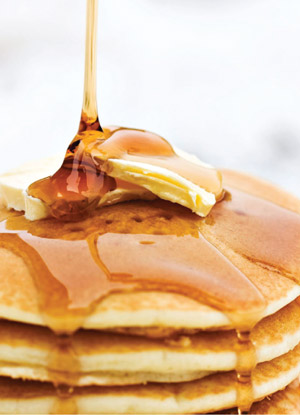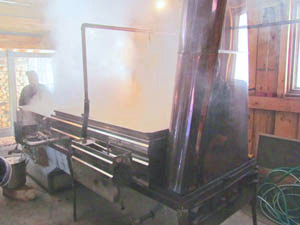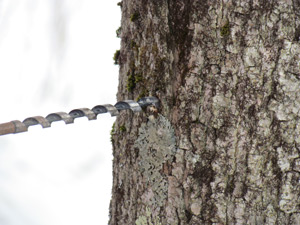Maple syrup: a healthy, versatile sweetener
by Karen McGeorge Sanders
This article was originally published in November 2013

As the leaves turn color, a pancake stack topped with real maple syrup makes a welcome treat.
The taste difference between real and artificial maple syrup is as distinct as between butter and margarine. Compared to sugar and artificially flavored syrups (corn syrup with maple flavoring), real maple syrup is a nutritional bonanza, an excellent source of minerals and antioxidants. It’s lower in calories than those sweeteners, too.
There are good reasons to choose organic maple syrup, which you’ll find at PCC in bottles and in bulk. It’s featured in more than 100 recipes on PCC’s website.
Nutrition
One reason to choose maple syrup instead of sugar is its health properties.
Maple syrup contains 101 calories per two-tablespoon serving, whereas cane sugar contains 108 and corn syrup contains 123. Two tablespoons of maple syrup fulfills half the daily requirement of manganese, an important nutrient that helps your body utilize nutrients, build a strong immune system, stabilize blood sugar and more.
Maple syrup also provides calcium, potassium, zinc and vitamin B2. It’s one of the few food sources of FOS, a prebiotic that supports good gut flora. Maple syrup also contains plenty of antioxidants.

It’s high in polyphenols, beneficial plant chemicals. Recently it was found that 54 of these antioxidant polyphenols are in maple syrup, including five not seen in foods before.
These antioxidants were isolated from maple syrup by Dr. Navindra Seeram, a University of Rhode Island associate professor specializing in medicinal plant research.
“Nature is the best chemist and maple syrup is a champion food when it comes to beneficial compounds,” says Seeram. “Several of these compounds have antioxidant and anti-inflammatory properties, which have been shown to fight cancer, diabetes and bacterial illness.”
Heating maple sap to syrup concentrates and creates nutrients including the newly discovered compound that Seeram named Quebecol. “Few other natural sweeteners have this antioxidant cocktail,” says Seeram.
Farming maples
“The hardest part of producing maple syrup is being at the mercy of the weather,” says Arnold Coombs, Director of Sales and Marketing at Coombs Family Farms. Coombs organic maple syrup is sold at PCC.
Sap runs when a freezing night is followed by a warm day, in the brief window between winter and spring. Trees cannot be tapped before they are 30 years old. Farmers drill holes on the side of the maple tree with the longest sun exposure. The sap is a clear, slightly sweet liquid, containing about 1-4 percent sugar. It takes 40 gallons of sap to make a gallon of syrup.
Why organic?
Organic maple farmers must not use pesticides or chemicals, nor can neighboring fields. The trees cannot be over-tapped.
Paraformaldehyde pellets to keep non-organic taps open have been illegal since the 1980s, but buying organic ensures no formaldehyde is in the syrup. The flow of maple sap is traced, making sure no contamination occurs. The syrup-making process is checked for cleanliness, defoaming agents and artificial additives.
Coombs explains, “At Coombs Family Farms, organic is about being good stewards of the forest and sustainable farming.”
Not all syrup is organic. Anything labeled pancake syrup is corn syrup with maple flavoring. There is also syrup that contains only 15 percent maple. Beware of these when not shopping at PCC. Even pure maple syrup may not be organic.

Maple syrup grades
Syrup is graded from lightest to darkest, from A to C, with several subcategories. Late-season syrup (usually grade B) is darker and used more commercially. “The darker grades have more polyphenols,” advises Seeram. They also have a stronger flavor.
For recipes where the flavor really matters (granola, cookies and cakes), you may wish to use Grade B because it has a much more complex maple flavor, often with hints of caramel. Grade A maple syrup’s more mild flavor is good for pancakes or cocktails.
